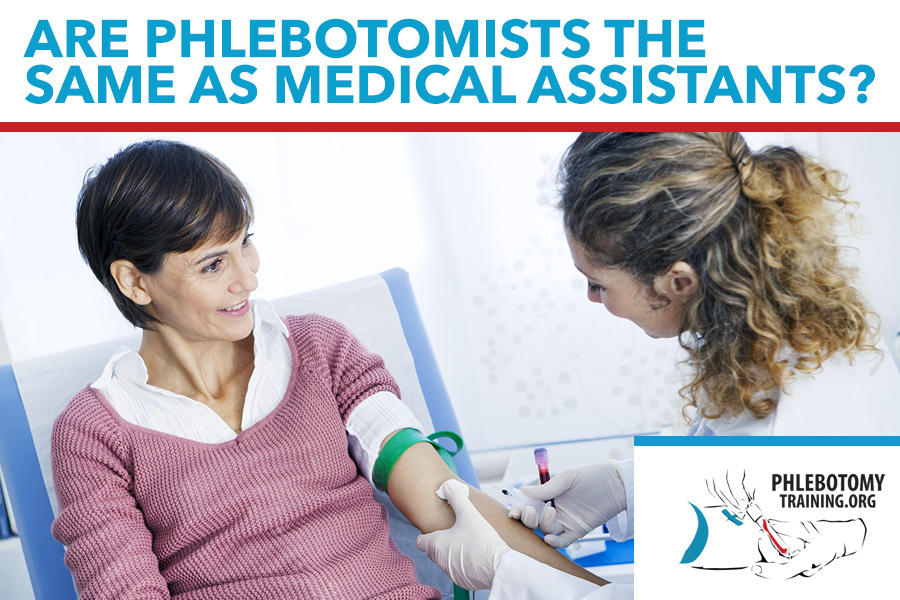Are Phlebotomists the Same as Medical Assistants?
In the intricate web of healthcare professionals, roles often intersect, leading to confusion regarding who does what. Phlebotomists and medical assistants are two roles that often get conflated. While both contribute to the functioning of medical facilities, they serve distinct purposes and possess unique skill sets. Understanding the differences between these two professions is crucial for patients, healthcare providers, and aspiring professionals alike.
Phlebotomist vs. Medical Assistant: An Overview
| Criteria | Phlebotomists | Medical Assistants |
|---|---|---|
| Primary Responsibilities | Drawing blood, labeling samples, and preparing specimens for laboratory analysis | Performing clinical tasks (e.g., taking vital signs, drawing blood), administrative duties (e.g., scheduling appointments, managing patient records) |
| Education Requirements | High school diploma or GED; completion of a phlebotomy training program | High school diploma or GED; completion of a medical assisting program |
| Certification | Certification preferred (e.g., Certified Phlebotomy Technician, CPT) | Certification often preferred (e.g., Certified Medical Assistant, CMA) |
| Work Settings | Hospitals, blood donation centers, diagnostic laboratories, clinics | Hospitals, clinics, physician offices, outpatient care centers |
| Scope of Practice | Focused on blood collection and specimen handling | Broad range of duties including both clinical and administrative tasks |
| Interaction with Patients | Primarily during blood draws and specimen collection | Extensive, including patient intake, taking medical histories, and assisting in examinations |
| Supervision | Often works under the supervision of a medical technologist or laboratory manager | Works under the supervision of physicians, nurses, or office managers |
| Skills Required | Precision in blood collection, knowledge of safety protocols, patient communication | Clinical skills, administrative skills, multitasking, patient communication |
| Job Outlook | Expected to grow due to increasing demand for diagnostic testing | Expected to grow due to the expanding healthcare industry and increasing demand for medical services |
| Average Salary | National average as of May 2023: $41,810 per year | National average as of May 2023: $42,000 per year |
| Advancement Opportunities | Limited; may require additional education for advancement | More opportunities; can advance to specialized medical assistant roles or transition into healthcare administration or nursing |
Defining Phlebotomists and Medical Assistants
Phlebotomists
Phlebotomists are healthcare professionals primarily responsible for drawing blood from patients for various purposes, including diagnostic testing, blood donations, transfusions, and medical research. They are trained to collect blood samples safely and efficiently, ensuring accuracy and patient comfort throughout the process. Phlebotomists work in a variety of settings, including hospitals, clinics, blood banks, and diagnostic laboratories.
Medical Assistants
Medical assistants, on the other hand, play a more diverse role within medical settings. They perform both administrative and clinical tasks to support physicians, nurses, and other healthcare professionals. Administrative duties may include scheduling appointments, managing patient records, and billing, while clinical responsibilities often involve taking patient vital signs, preparing examination rooms, assisting with minor medical procedures, and providing patient education.
Education and Training
Phlebotomists
Phlebotomists typically undergo specialized training programs that focus specifically on venipuncture techniques, blood collection procedures, patient interaction, infection control, and specimen handling. These programs can vary in length but often range from a few weeks to several months. Many phlebotomy training programs culminate in a certification exam, and some states may require phlebotomists to be certified or licensed.
Medical Assistants
Medical assistants generally complete formal training programs that cover a broader range of medical and administrative tasks. These programs, which can lead to a certificate, diploma, or associate degree, typically include coursework in anatomy, physiology, medical terminology, pharmacology, office procedures, and clinical skills. While certification is not always mandatory for medical assistants, obtaining certification from recognized organizations such as the American Association of Medical Assistants (AAMA) or the National Healthcareer Association (NHA) can enhance job prospects and demonstrate competency in the field.
Scope of Practice
Another important distinction between phlebotomists and medical assistants lies in their scope of practice and the specific tasks they are authorized to perform.
Phlebotomists
Phlebotomists are primarily focused on blood collection and specimen handling. Their responsibilities include identifying patients, selecting appropriate venipuncture sites, preparing equipment, collecting blood samples, labeling specimens accurately, and ensuring proper storage and transportation of samples to the laboratory. Phlebotomists must adhere to strict protocols to prevent contamination, minimize patient discomfort, and maintain the integrity of collected specimens.
Medical Assistants
Medical assistants have a broader scope of practice that encompasses both clinical and administrative duties. In addition to assisting with blood draws and specimen collection, medical assistants may perform tasks such as taking patient histories, recording vital signs, administering medications (under the direction of a licensed healthcare provider), performing electrocardiograms (EKGs), removing sutures, and providing patient instructions. On the administrative side, medical assistants may handle phone calls, schedule appointments, complete insurance forms, and maintain medical records.
